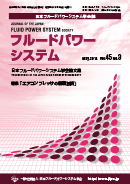All issues

Volume 45 (2014)
- Issue 6 Pages 85-
- Issue 5 Pages 73-
- Issue 4 Pages 51-
- Issue 3 Pages 29-
- Issue 2 Pages 15-
- Issue 1 Pages 1-
Volume 45, Issue 3
Displaying 1-3 of 3 articles from this issue
- |<
- <
- 1
- >
- >|
Paper
-
Ali AKPEK, Chongho YOUN, Toshiharu KAGAWA2014Volume 45Issue 3 Pages 29-36
Published: 2014
Released on J-STAGE: July 27, 2015
JOURNAL FREE ACCESSIn viscosity measurement, temperature control is very important. In this study, the effects of temperature distribution on vibrational viscometers are investigated. Vibrational viscometers are preferred over other types of viscometers owing to their low cost, easy to use and efficacious continuous viscosity measurement capability. The study was conducted in two parts. In the first part, the challenge of unequal temperature distribution in vibrational viscometers was analyzed. The heat generated by a heater during continuous viscosity measurement disperses every part of a sample fluid and influences the fluid's viscosity. Therefore, the sample fluid may have inhomogeneous viscosity values because temperature distribution cannot be equal at every point in a fluid. This experiment is repeated several times with different temperature gradients for gaining a better understanding about the effect of unequal temperature distribution on fluid viscosity. Experimental outcomes show that under some conditions, viscosity measurement errors could reach 27.9%. This finding has been verified by mathematical calculations. In the second part of the research, for solving the unequal temperature distribution problem, the use of a magnetic stirrer for mixing up the fluid throughout the viscosity measurement with the aim of achieving homogenous temperature distribution is proposed.View full abstractDownload PDF (1672K) -
(1st Report: Three-Dimensional Flow Analysis with a Turbulence Model and Estimation of Leakage Flow Rates)Takahiro KOSAKI, Manabu SANO2014Volume 45Issue 3 Pages 37-41
Published: 2014
Released on J-STAGE: July 27, 2015
JOURNAL FREE ACCESSA pneumatic cylinder with a labyrinth seal has considerably lower friction than that with a rubber seal has, because no mechanical contact between the piston and the cylinder tube exists. However, air leakage from clearance between the piston and the cylinder tube is inevitable. This paper focuses on an investigation on leakage flow through the labyrinth seal inside a labyrinth-sealed pneumatic cylinder based on computational fluid dynamics (CFD). The CFD analysis is conducted with an ANSYS FLUENT system and, by employing a turbulence model, the leakage flow around the labyrinth seal is simulated and visualized. From the CFD analysis results, the leakage rates are found and they are compared with experimentally measured data which are acquired by means of our constructed measurement apparatus. Furthermore, we define an index to quantitatively evaluate the intensity of the turbulent flow for reducing leakage and discuss the availability of the proposed index by applying it to some CFD analysis results.View full abstractDownload PDF (1454K) -
(2nd report) Reference Shaping for Improving the Transient Response ―Development of New Posicast Control―Hiroaki KUWANO2014Volume 45Issue 3 Pages 42-49
Published: 2014
Released on J-STAGE: July 27, 2015
JOURNAL FREE ACCESSMany kinds of electro-hydraulic servo systems are applied to rolling mills such as a hot strip mill, a cold strip mill and a seamless tube mill because of quick response, high power and high positioning accuracy. However when applying an electro-hydraulic servo system to a hot strip downcoiler, it was found that the controlled object has low natural frequency and is lightly damped so that stable control is very difficult. In the former report, optimal control theory was applied in order to improve these characteristics. However, the derived control system was found to be poor in robustness. Especially, the control effectiveness was highly influenced by the response of the servo valve and the length of piping between the servo valve and the cylinder. In this report, a newly developed control system has been presented, and was found in the adjustment of the control system applied to the production machine. The new control system belongs to a kind of Posicast Control proposed by O.J.M. Smith in 1957. However the final type of this system, named new Posicast Control, has realized a robust control and a kind of Dead-Beat Control.View full abstractDownload PDF (3557K)
- |<
- <
- 1
- >
- >|